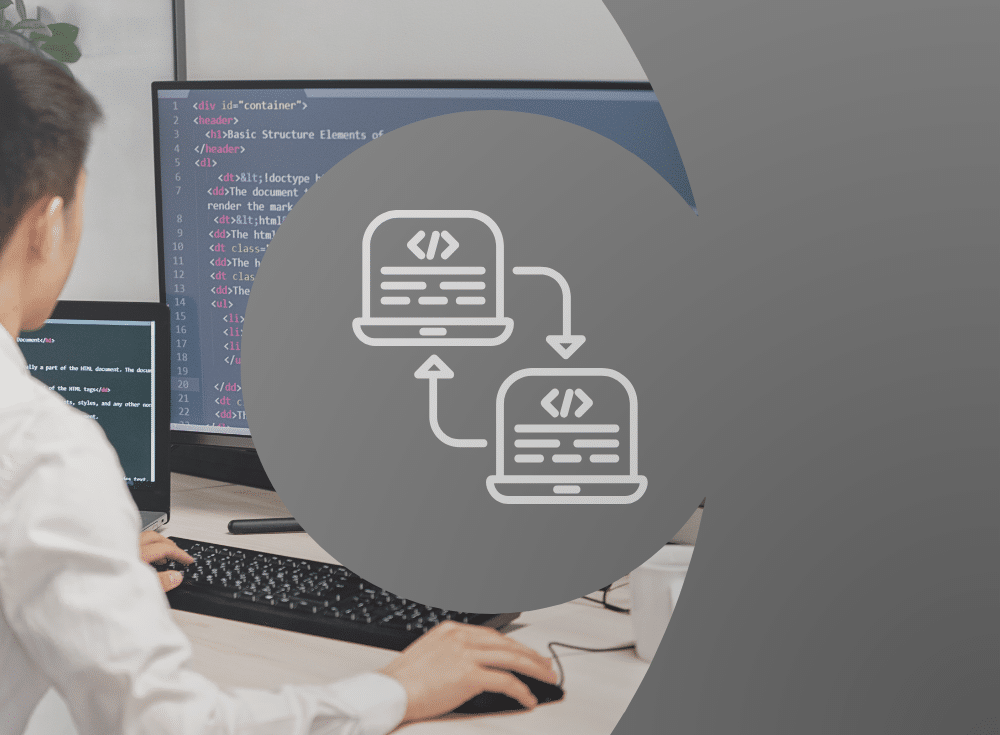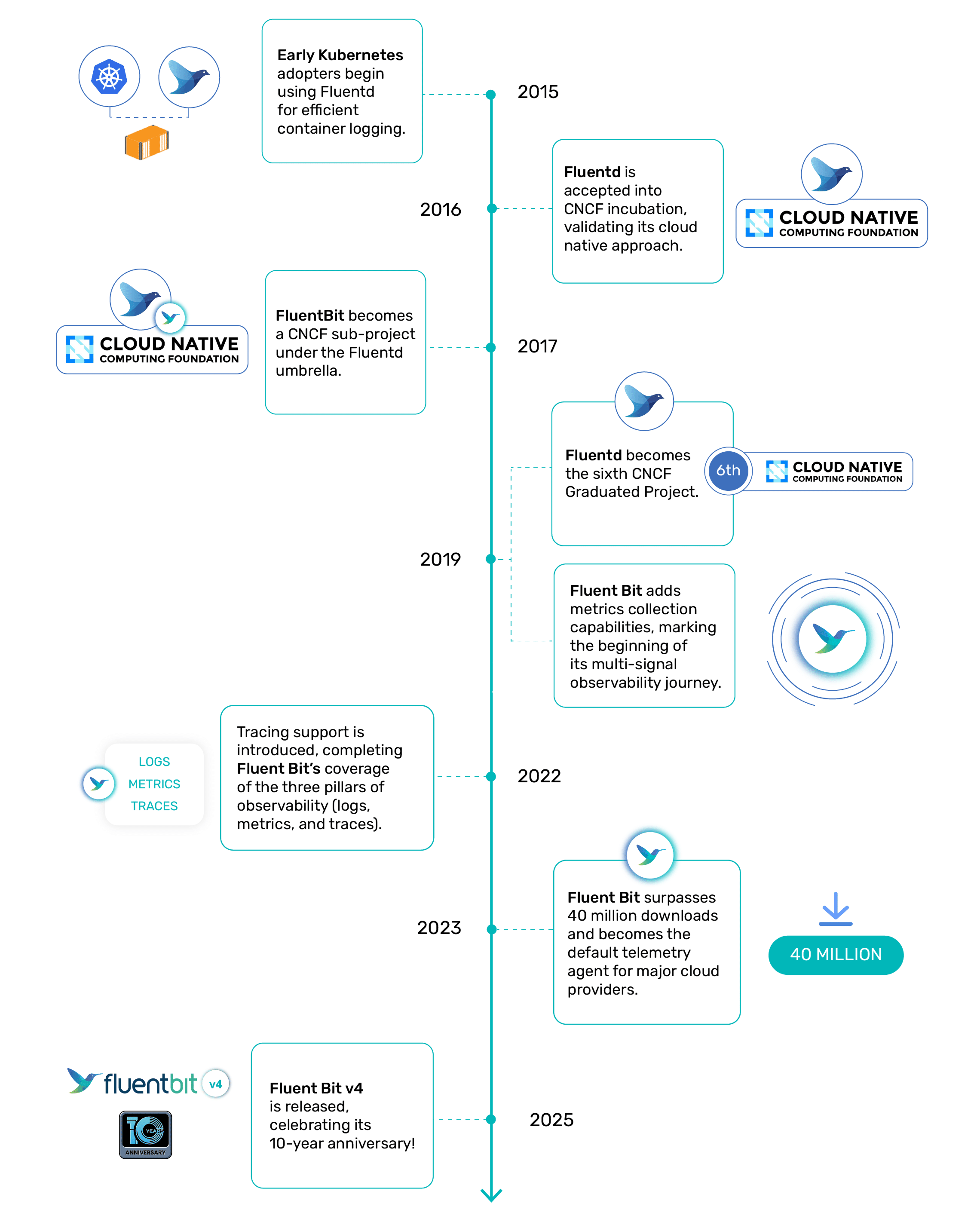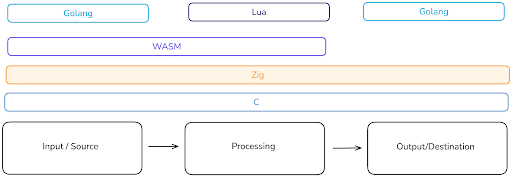The Journey: From embedded logging to multi-Signal observability
With over 15 billion downloads, integration with every major cloud provider, and adoption by thousands of enterprises, Fluent Bit has become the production-grade telemetry pipeline for cloud native environments.
Fluent Bit began in 2014 with a clear mission: create a lightweight, high-performance log processor that could run efficiently in resource-constrained environments. What distinguished Fluent Bit from the start was its commitment to performance and minimal resource consumption—principles that continue to guide development today.
The project’s journey has been marked by consistent growth and evolution:
Throughout this journey, Fluent Bit has maintained its core values: high performance, lightweight footprint, and vendor neutrality. These principles have made it the preferred choice for organizations seeking a reliable observability foundation without vendor lock-in or performance compromises.
Introducing Fluent Bit v4: The next generation
Building on a decade of engineering excellence, v4 introduces transformative capabilities that expand what’s possible with a telemetry agent while maintaining backward compatibility and the performance users expect. Here are four fantastic features you’ll find in v4:
- Conditional Logic for Processors
- Head and Tail Sampling for Traces
- Zig Language Support for extending Fluent Bit
- Authentication and TLS Improvements
Adding conditional logic for processors
When v2.12 was released, Fluent Bit introduced the concept of Processors, which can enrich or transform telemetry data. Then with v3, Fluent Bit expanded on this foundation by introducing three key processors: Content Modifier, Metric Selector, and which follows last year’s new support for the OpenTelemetry Envelope Enveloper.
The ability to transform data in processors by writing rules and configurations is powerful but also complex – until now. With v4, Fluent Bit offers intuitive conditional logic that makes it dramatically easier to implement sophisticated data transformations while improving pipeline performance and efficiency.
Conditional logic in processors significantly reduces bottlenecks in high-volume data streams, which is especially powerful for use cases with heavy regex processing or complex data transformations.,
Here’s an example of how you can use conditional processing to delete sensitive information based on user permissions:
service:
flush: 0.2
pipeline:
inputs:
- name: dummy
dummy: '{"user": "admin", "roles": ["read", "write", "delete"], "secret": "abc123"}'
outputs:
- name: stdout
processors:
logs:
- name: calyptia
actions:
- type: delete
opts:
key: secret
condition:
operator: AND
rules:
- field: '$roles'
operator: not_in
value: ["admin", "superuser"]
- field: '$user'
operator: neq
value: "system"This configuration will transform:
Example 1:
| Condition | JSON Data |
|---|---|
| Met |
{
"user": "admin",
"roles": ["read", "write", "delete"],
"secret": "abc123"
}
|
| Secret Key Deleted |
{
"user": "admin",
"roles": ["read", "write", "delete"]
}
|
Example 2:
| Condition | JSON Data |
|---|---|
| Condition Not Met |
{
"user": "system",
"roles": ["superuser"],
"secret": "abc123"
}
|
| No Change |
{
"user": "system",
"roles": ["superuser"],
"secret": "abc123"
}
|
Head and Tail Sampling for Traces
Fluent Bit v4 now offers a new trace sampling processor designed with a pluggable architecture, which allows easy extension to support multiple sampling strategies and backends.
The two main approaches for sampling traces are head and tail sampling:
- Head sampling makes the decision whether or not to keep a trace at the very beginning. This is when a root span is created but before the request is actually fulfilled.
- Tail sampling evaluates the entire trace when making a sampling decision and can inspect the metadata and status of traces to inform the decision.
Here’s an example showing head sampling configured at 40%, which would result in approximately 40 traces sampled out of an original dataset of 100.
pipeline:
inputs:
- name: opentelemetry
port: 4318
processors:
traces:
- name: sampling
type: probabilistic
sampling_settings:
sampling_percentage: 40
outputs:
- name: stdout
match: '*'
Trace data volumes can quickly become overwhelming and expensive to store. Intelligent sampling ensures you capture the most valuable traces for debugging and performance analysis while managing costs. I am excited to see expanded support for traces — it means Fluent Bit continues to be a powerful choice for handling all your cloud native telemetry. This is an area the Fluent Bit maintainers are actively working on and welcome your feedback, friction logs, and feature wishlist when it comes to managing traces with Fluent Bit.
Whitepaper: Getting Started with
Fluent Bit and OSS Telemetry Pipelines
Getting Started with Fluent Bit and OSS Telemetry Pipelines: Learn how to navigate the complexities of telemetry pipelines with Fluent Bit.
Zig Language Support for extending Fluent Bit and developing plugins
If you’ve been wanting to contribute to or customize Fluent Bit but weren’t keen on learning the ins and outs of C, you’ll be excited to learn about our support for the Zig language! Zig is a modern systems programming language that combines C-like performance with memory safety and expressive syntax. This complements existing C and Lua plugin options, enabling developers to create high-performance extensions with fewer bugs and security vulnerabilities.
Going forward Zig will complement existing extension options like Golang, Lua and WASM opening the door to more contributions from a broader community of developers
Learn more about Zig here and check out their list of learning resources to get started today!
Authentication and TLS Improvements
As observability data increasingly contains sensitive information and spans multiple security domains, robust authentication and encryption are essential. These v4 improvements enable secure telemetry collection across complex environments.
First is the ability to load Bearer tokens directly from the filesystem—a big improvement over manual configuration. Second, the Fluent Bit maintainers have responded to community requests for more choice and flexibility for the cipher used to encrypt communication via TLS.
Looking ahead: The next decade of Fluent Bit
As we celebrate this milestone, it’s amazing to watch how the community has helped make Fluent Bit’s success possible. From individual contributors and maintainers to enterprise adopters, your feedback, contributions, and support have shaped this project into what it is today.
Fluent Bit v4 isn’t just a culmination of our first decade—it’s the foundation for the next ten years of innovation. We envision Fluent Bit continuing to evolve as observability practices mature, becoming increasingly intelligent about the data it processes while remaining true to its core principles of efficiency and vendor neutrality.
I recommend upgrading to v4 today so you can experience first-hand how these transformative capabilities can enhance your observability practice.
Ready to get started? Learn more about Fluent bit v4, join our growing community, and visit our documentation to learn more about upgrading. Here’s to the next decade of observability excellence with Fluent Bit!
Buyer’s Guide: Telemetry Pipelines
Build a smarter telemetry pipeline. Download The Buyer’s Guide to Telemetry Pipelines






